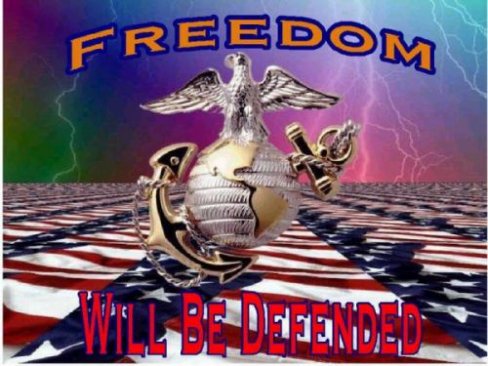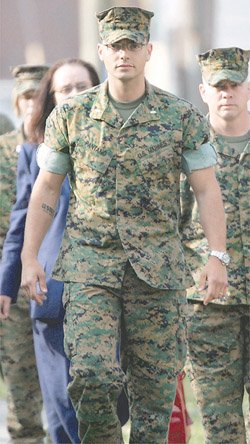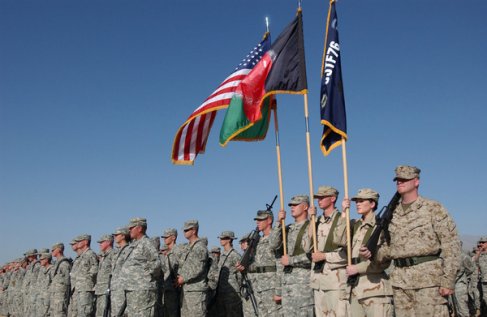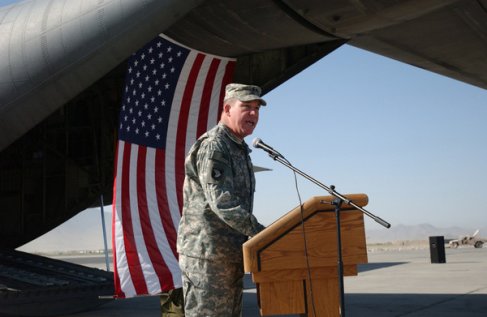Most of the Speech Given at the American Enterprise Institute
To get home, or back to work, you have to go through those doors there. Now, lets pretend those doors may be booby trapped and the first person and anyone within 5 feet of the doors is going to get some shrapnel. But, you gotta cross the threshold. And, on the other side of the doors, there might be a guy with an RPK machine gun waiting to throw some lead at you. And down the hall, there may be a guys hiding around the corners with AK-47s. But, after all that, you make it outside, where there could be snipers. Then you make it to your car or cab, and then there is a chance someone is waiting to blow you up with an IED. And, once you have made it home, there is a good chance someone is going to try and lob a mortar or rocket into your subdivision.
That is what it is like to be a Marine infantryman, or, a photographer who spent 5 months with a Marine infantry platoon in Al Anbar province.
Now, after hearing that scenario, if you said, ‘no thanks,’ congratulations: you are normal. But if you heard that and said, ‘heh, whatever’ I know some recruiters who may want to talk to you. Most reporters, being normal, aren’t exactly eager to chase grunts around Al Anbar.
In spring of 2005, I left my life behind and traveled to Iraq as an embedded reporter.
I spent 5 months living with a Marine infantry platoon, walking the streets of places like Karmah, Amiriya, and Ferris. I spent days and weeks outside the wire, sleeping on the dirt, lining up in the stack as the Marines hit target houses and all the time those nights and days punctuated with the call to prayer.
I drank tea and smoked cigarettes with sheiks and Imams. I sat down and ate with men who led villages and families. I bartered with shop keepers for sodas and cigarettes, played soccer with kids. And, I spent a lot of time getting sun burned.
Punctuated by the rare few minutes of intense violence, most of the time the Marines chatted up the locals, gathered intel and chased leads.
I have concluded, based both on my experience, and the reports of other newsmen, that an unconscionable amount of what we in the press have been feeding the American public regarding the war in Iraq is fashioned by the propaganda arms of our enemies. Ba’athist kidnappers and Jihadi bombers are planning their operations not to win the war in Iraq, but to win it in America. To that end, they are assessing what American reporters are willing to cover, and what American news organizations are willing to risk.
This has been made abundantly clear in Al Qaida documents recently released by Centcom and the Coalition. An excerpt of the translated document reads:
The policy followed by the brothers in Baghdad is a media oriented policy without a clear comprehensive plan to capture an area or an enemy center. In other words, the significance of the strategy of their work is to show in the media that the American and the government does not control the situation and there is resistance against them.
Stated simply: Al Qaida is not even trying to win the war on the ground anymore. It is attempting to win the war in the press.
And they’re doing pretty well. On April 2, 2005, when Al Qaeda in Iraq attempted to assault Abu Ghraib prison, I was the only reporter there. The unit I was with was patrolling the area as part of a week-long op, and caught the tail end of the assault. The Marines didn’t think much of it. The main result was a bunch of dead insurgents. The next day, when the sun came up, we saw the v-beds that didn’t even make it off the highway and the remnants of so-called lions of taweed.
It wasn’t until we were back in base, watching TV in the chow hall, that we discovered that the failed assault was “BIG NEWS” and reporters were showing up after the fact. Two-to-three days after the fact.
As a Marine Colonel told me. Al Qaeda lost that fire-fight in Iraq, but they won on CNN.
In the Spring of 2005 — before I went to Iraq — while I was going from TV station to TV station selling my syndicated news reports to local News Directors, I used a very simple sales pitch:
I would ask: How often do you air coverage of the war? Every day, in some form right? They would nod yes. Then I would ask: how often do you get a local tie-in? They would think about it, but I already knew the answer. For local TV stations there are only 4 Iraq stories:
Local Units leaves, local boy killed in action, wife of local boy being screwed over by the mortgage holder, local unit comes home. On one station I saw them hit the Superfecta with all four stories in one night.
Then, I would ask: How often do you have footage and an interview with a local boy, a grunt out there fighting the war on terror with video of him in action?
The answer was invariably never.
Some of the stations bought my feeds on the spot. And if I could make money going to Iraq as a one person shop, and Michael Yon, Bill Roggio and Michael Totten can report from Iraq with support only from tip jars on their blogs, then there is obviously a market for news beyond the daily car bombing.
But you wouldn’t know it from the war coverage on network and cable news.
The two most common are the Balcony shot of a reporter recapping the latest car bombing, and the computerized map showing the latest bombing. Less often, you get an interview with some Iraqis, nearly always in Baghdad invariably saying how bad things are. And in the rarest of these a real live U.S. newsman reports with a coalition unit, usually long after a major event, as in “Tal Afar six months later,” “Mosul six month later,” and the one I saw most, “Fallujah Six months later.” And of course, “Abu Ghriad, two days after a major attack.”
Al Qaida and its fellow travelers have used violence, kidnappings and the ever present threat of violence against reporters to lock down news coverage.
With Western reporters holed up in bunkers, their view of the war is filtered by Iraqi stringers, who as noted by the Center for Strategic and International Studies, may be plants for the terrorists, terrorist sympathizers or feeling the same pressures of violence felt by Western reporters.
The only thing this kind of news-gathering yields is the result of terrorist violence. But that, of course, is the insurgents’ goal —to create the perception in the western media that Iraq is out of control.
What you will not see in the media is what I saw in Iraq…a lot of every day life.
For every minute of violence and danger, there would be days of eating flat bread, drinking tea, and sitting around in positions hoping to get shot at.
Yes, trying to get shot at. At least one third of the operations I went on with the Marines were bait and kill operations—why my platoon was always the bait, I don’t know, it just worked out that way.
In the media, you never hear of the units where everyone came home alive. There are no stories about an operation in which the high-light was the tribal Sheik insisting the Platoon come to his son’s wedding. There is never the tag line—In other news, most Iraqis went about their business of saving up enough money to buy a satellite dish and pay their cell phone bill—yes, every mud hut seems to come equipped with a satellite dish—so they too can watch the latest news about a car bombing in Baghdad in between Jordanian soap operas.
The terrorist goal of winning through the media has worked.
The result is a picture of Iraq in which small slices are accurate– the basic facts about the recent bombing are accurate—but where the majority of the canvass is left blank, turning the small slices into the entire portrait.
“Iraq is unquestionably the biggest story of our time, and one which will affect American foreign and domestic policy for the rest of our lives — but if news organizations won’t invest the money and manpower to cover it from top to bottom, it will end up becoming a story told only through its major disasters and victories, without many of the small, personal narratives and struggles that give the story its humanity.”


















Recent Comments